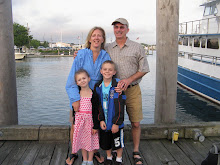Part 1:
Creating and reflecting on my GAME
plan has been a useful and practical way to prepare my students for a future where
collaboration and technology are expected in the workplace. The feedback my
classmates wrote on my blog provided links and suggestions to new learning. I learned
ways to better reach my goal of adding technology assessments and evaluations
in my classroom, and tips and techniques to monitor my students’ learning in a
technology enhanced environment. I have
bookmarked links and resources that have provided me assistance in choosing
project based learning and digital storytelling assessments so that I have a better
well-rounded assessment grade book in my third grade classroom. In addition,
this has impacted my classroom by providing motivation ways to assess my
learners. I have yet to see a class that gets excited when the teacher assesses
them. Adding technology assessments has changed their assessment attitude. Now,
when I introduce a project based or digital storytelling project, my students’ enthusiasm
is evident.
Following and learning about the
GAME plan process has been a beneficial experience. I am still constantly
revising ways to add a technology assessment project each marking period. For
example, I recently did a digital storytelling project and collaborated with an
older grade. Since my students had help
I struggled a bit on how best to assign a grade using the rubric that I
developed. I will continue to research how to use technology collaboration
projects and look for rubrics that align better to this type of learning.
Using the GAME plan format with my third
graders is something I would like to try in the future. The most beneficial
part would be to lead my students to understanding how to monitor their learning
and change it to make it better. This is not impossible, but a challenging
concept for the age of the students in my classroom. They often see any work they do as their best
and critiquing and changing it is a whole new way of learning for them.
Part
2:
This course has given me the understanding
behind integrating problem based learning, social networking/online
collaboration, and digital storytelling into my instruction. One huge advantage is how these types of
projects are easy to differentiate for the varied learners in my classroom. This helps me to improve my classroom
environment to connect with all of my students.
Dr. Abrams mentions “visual
literacy” as a core characteristic of the present generation of students
(Laureate Education, Inc, 2010). This point has helped me understand the
importance of using a combination of written literacy with 21st century
literacy. Some immediate adjustments that I plan to make in my instructional
practice are to continue include problem based learning and digital
storytelling in other content areas. I am developing a digital storytelling
unit in science where my students will be teaching the class an area of the
water cycle unit, by creating a digital story. In addition, I plan to Skype an
expert meteorologist as a way to use social collaboration learning to the unit.
One of the most important things
that I learned in this course is to use social media as a way to reach out to
other educators for ideas. Without feedback from my classmates and instructor, the
monitor, evaluate and extend parts of my GAME plan would be difficult to successfully
complete. I will continue using social media as a way to grow as an educator.
Moving forward,
I can say with confidence that the GAME plan process has given me the tools
necessary to create a technology environment that motivates and increases my young
students' focus in my classroom. My
weekly lesson plans will include more technology in the form of project based
learning, educational/social media, and digital storytelling projects. In
addition, I will continue to make small changes in the areas of tweaking my grade
book to include a blend of traditional and 21st century assessments.
My classroom has evolved over the past seven weeks and transformed to include more
meaningful curriculum based technology projects.
References
Cennamo, K., Ross, J. & Ertmer, P. (2009).
Technology integration or meaningful classroom use: A standards-based approach.
(Laureate Education, Inc., Custom ed.). Belmont, CA: Wadsworth, Cengage
Learning.
Laureate
Education, Inc. (2010a). Spotlight on Technology: Digital Storytelling, Part
1. Retrieved February 17, 2013, from Walden University: https://class.waldenu.edu/webapps/portal/frameset.jsp?tab_tab_group_id=_2_1&url=%2Fwebapps%2Fblackboard%2Fexecute%2Flauncher%3Ftype%3DCourse%26id%3D_2097789_1%26url%3D
Laureate Education, Inc.
(2010b). Spotlight on Technology: Digital Storytelling, Part 2 [videocast].
Retrieved February 17, 2013, from Walden University: https://class.waldenu.edu/webapps/portal/frameset.jsp?tab_tab_group_id=_2_1&url=%2Fwebapps%2Fblackboard%2Fexecute%2Flauncher%3Ftype%3DCourse%26id%3D_2097789_1%26url%3D

No comments:
Post a Comment